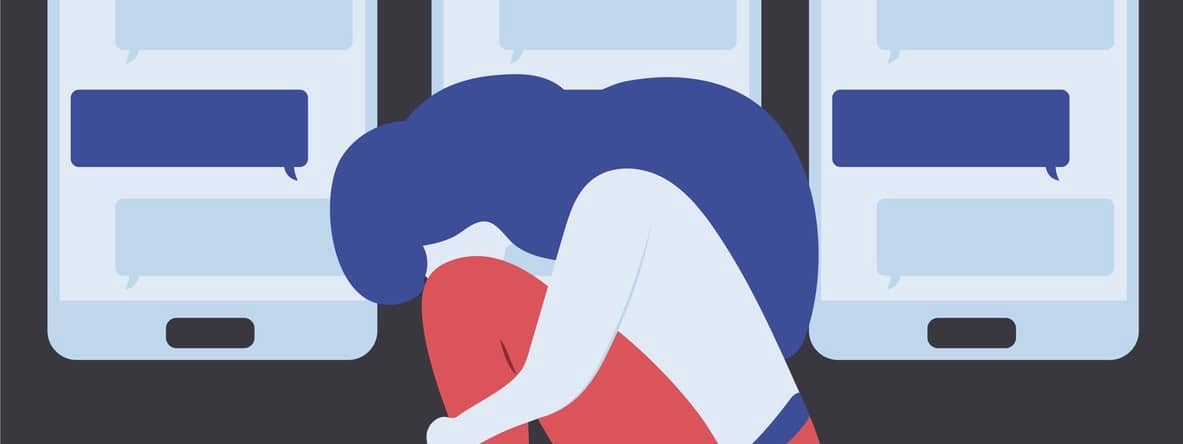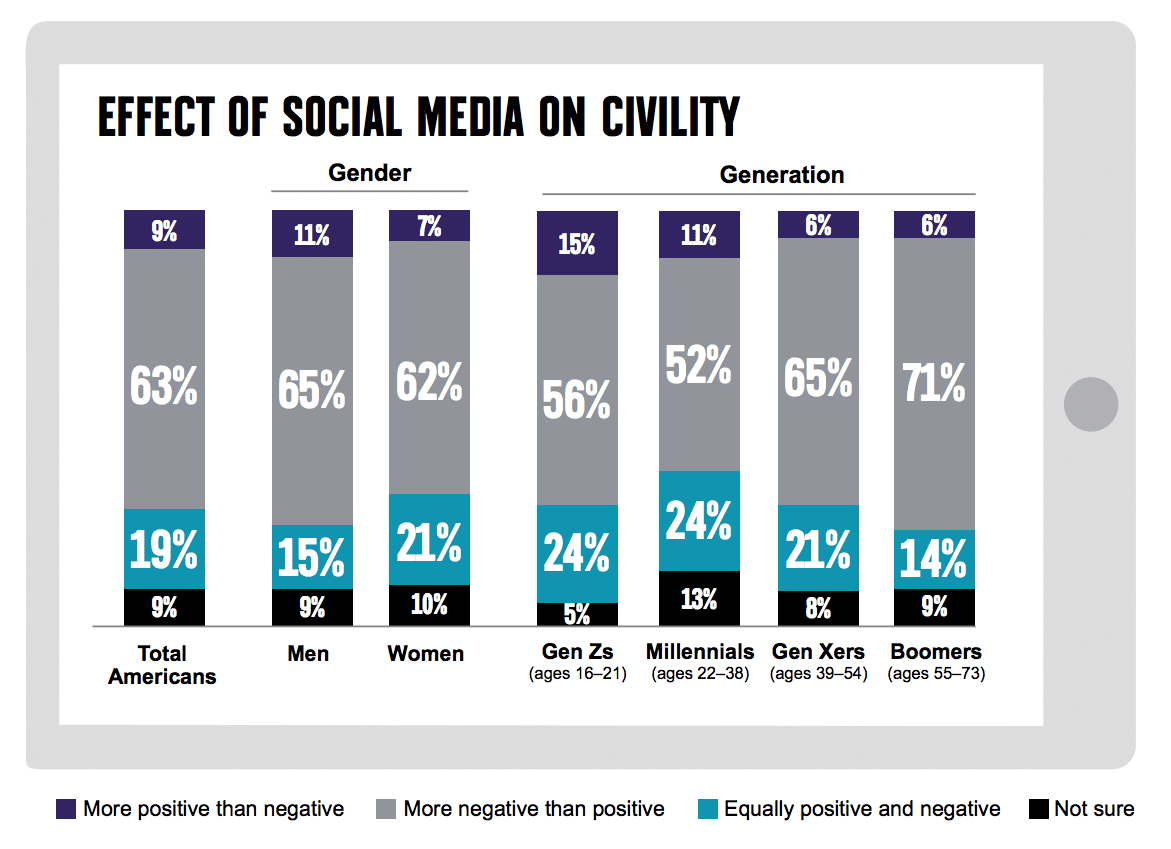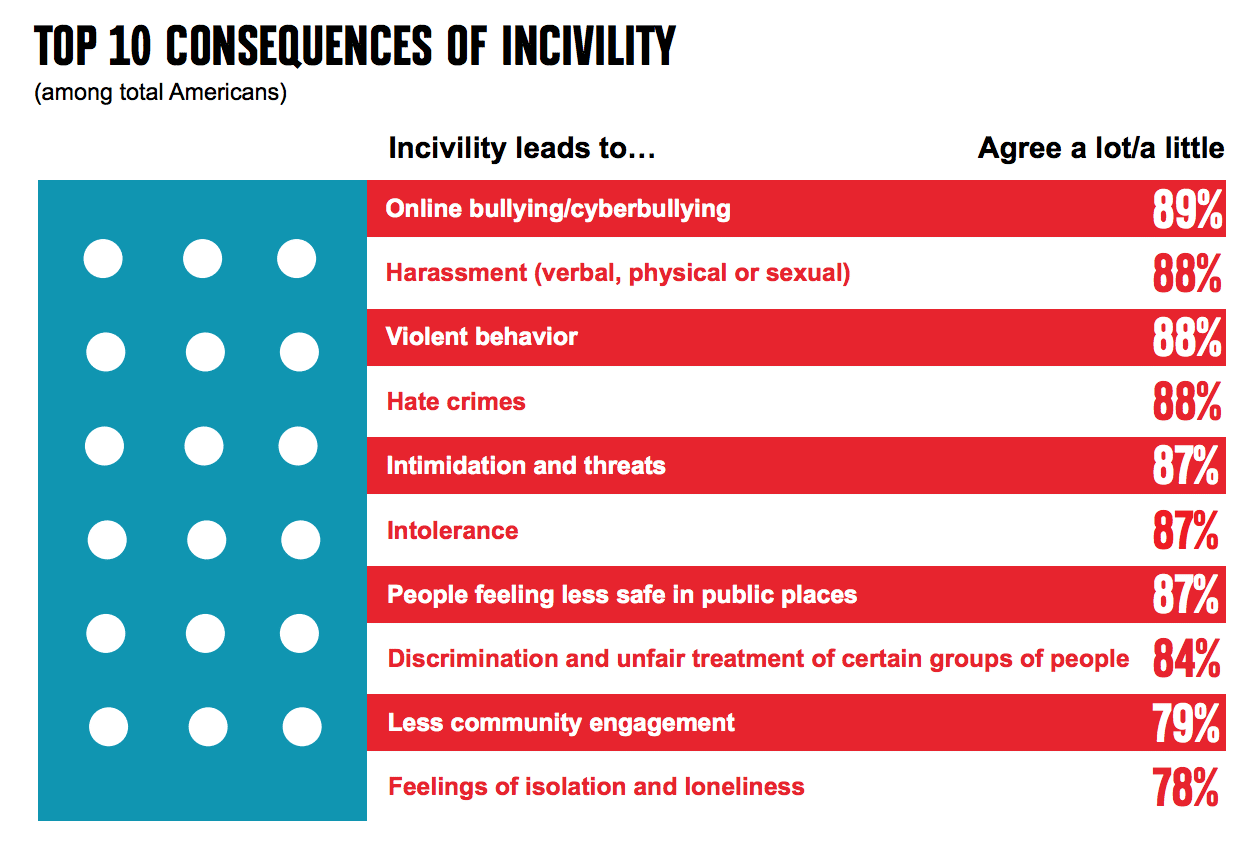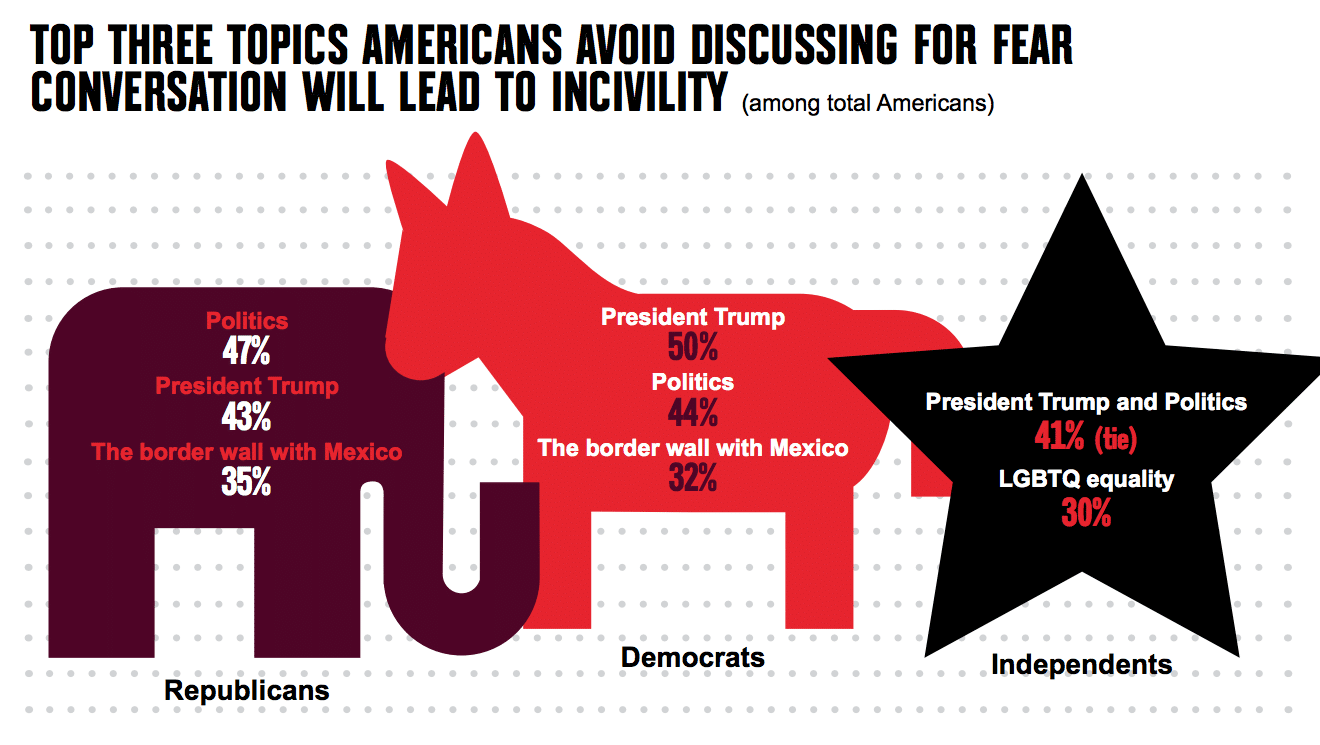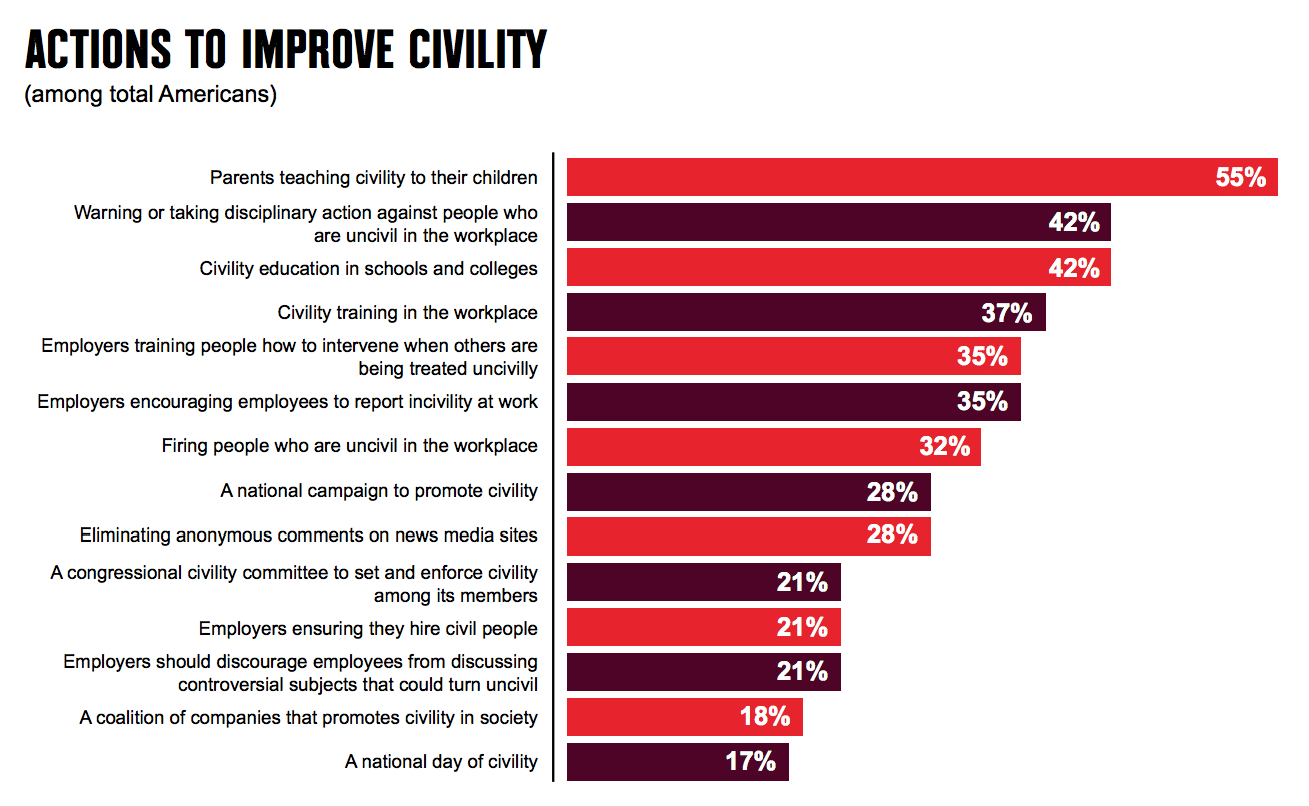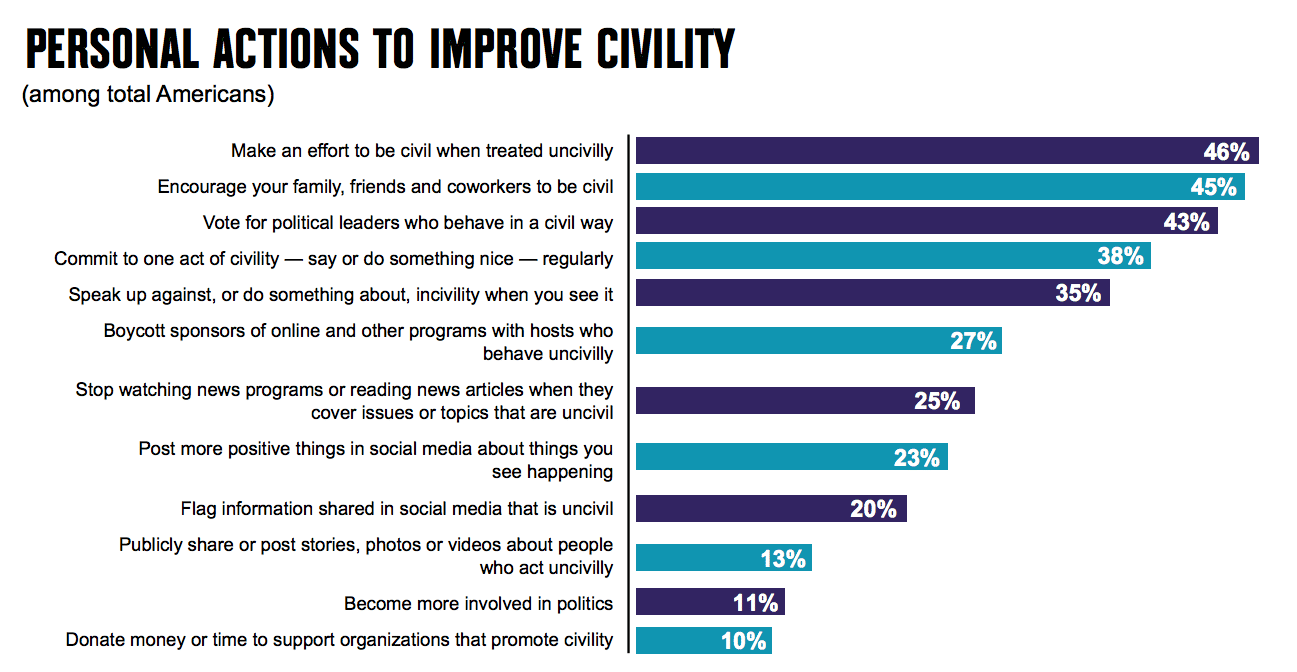From our flame-throwing politics to our ever-widening divisions on cultural hot-button issues like immigration and guns, there’s plenty going on in America to get riled up about. Indeed, a new poll from Weber Shandwick and Powell Tate has tracked the state of civility in the United States since 2010, and once again finds that the vast majority of Americans—a whopping 93 percent—identify a civility problem, with most classifying it as a “major” problem (68 percent).
And contributing heavily to the cause of incivility is social media
Sixty-three percent of Americans say that, in their experience, the impact of social media on civility been more negative than positive. According to the firms’ new report, Civility in America 2019: Solutions for Tomorrow, conducted in 2019 with KRC Research, only nine percent say it has been more positive than negative.
“Since the inception of this study nearly a decade ago, the eroding state of public discourse in America has been of great concern to Americans,” said Andy Polansky, CEO of Weber Shandwick, in a news release. “Although social media has risen over the years as a source of incivility in this nation, other factors such as politicians, the news media and America’s youth are also consistently blamed. We remain optimistic that Americans can rise above the incivility they encounter on social media and engage in less divisive discourse in every aspect of their lives.”
The finding that social media has had a more negative than positive impact on civility is an experience common to multiple demographic groups. Negativity decidedly outweighs positivity by large margins regardless of gender, generation and race. Even within the generation that is native to social media—Generation Z (who in our study are 16-21 year olds)—a massive gap emerges of nearly 4:1 between those who say social media’s effect has been more negative than positive vs. more positive than negative (56 percent vs. 15 percent, respectively). Hispanics express the most positivity with 27 percent reporting that, in their experience, social media has had a more positive than negative impact.
Social media is perceived at the root of incivility and increasingly problematic
More than one-half of Americans (54 percent) expect the general tone and level of civility in the country to decline even further during the next few years. Among this group, 57 percent believe that the Internet and/or social media are to blame, a factor that tops the list of 19 possible choices.
The researchers first presented “the Internet and social media” as a potential cause of civility erosion in 2012. At that time, just 24 percent who saw civility declining identified it as a cause. The increase in blaming the Internet and social media for the demise of civility has more than doubled since the firms began investigating its role (from 24 percent in 2012 to 57 percent in 2019).
Over the years, the number of uncivil online interactions that Americans have experienced has grown. In 2013, they claimed an average of 4.4 uncivil interactions online per week. That rate is now at an average of 5.5 uncivil interactions online per week. Interestingly, this trend of increasing uncivil online interactions has flipped since our tracking of this metric began to reveal a reduction in uncivil in-person interactions, from 5.9 in 2013 to 4.7 in 2019.
This year, the firms surveyed a segment of high school-aged teens, 16 and 17 year olds, to assess their perceptions of the state of civility. Among those who expect civility to worsen during the next few years (69 percent), by far their top reason for the erosion is social media (66 percent). This is probably linked to high schoolers’ greater likelihood of reporting experiences of incivility on social media (57 percent), compared to their older 18-21-year-old Gen Z cohorts (51 percent), Millennials (47 percent), Gen Xers (40 percent) and Boomers (33 percent).
A civil workplace benefits employers and employees alike
Despite the unwavering sentiment that America has a civility problem, a positive note is sounded on the general level of civility in the workplace. Nine in 10 Americans who work with others (89 percent) describe their place of employment as very or somewhat civil. This has been a consistent finding since we began asking about civility in the workplace in 2017.
A civil workplace affects job performance in positive ways. Nearly eight in 10 employees with coworkers (78 percent) report that civility at work provides tangible upsides. Four in 10 say civility at work improves their work morale and increases their loyalty to their employer (40 percent each) and nearly as many say it improves their quality of work (36 percent).
When people encounter incivility at work, their most commonly reported reactions are to ignore the person acting uncivilly (54 percent) and to remove themselves from the situation (49 percent). Far fewer speak directly to the uncivil perpetrator (24 percent) or contact their supervisor or HR department (11 percent) to report the uncivil behavior.
Americans see solutions for improving civility in America
This year, researchers made a point of asking Americans what could be done to improve civility and the extent to which people would be personally willing to make a difference.
“Civil discourse is a key to a healthy democracy,” said Pam Jenkins, president of Weber Shandwick Global Public Affairs, in the release. “The public has identified our civility problem, and it is now up to all of us to encourage the solutions that will make our government and society work better.”
The types of actions that people believe would improve the level of civility in our nation include broad support for solutions ranging from greater parental responsibility to corporate measures to civility training.
- Parents teaching civility to their children (55 percent)
- Warning or taking disciplinary action against people who are uncivil in the workplace (42 percent)
- Civility education in schools and colleges (42 percent)
- Civility training in the workplace (37 percent)
- Employers training people how to intervene when others are being treated uncivilly (35 percent)
- Employers encouraging employees to report incivility at work (35 percent)
On a more personal level, Americans selected actions (from a list of 12) that they would do themselves to improve civility. The vast majority (88 percent) selected at least one action. On average, they chose 3.4 actions, demonstrating that there is desire among Americans to make civility a personal responsibility. The most common actions are:
- Making an effort to be civil when treated uncivilly (46 percent)
- Encouraging family, friends and coworkers to be civil (45 percent)
- Voting for political leaders who behave in a civil way (43 percent)
- Committing to one act of civility—say or do something nice—regularly (38 percent)
- Speaking up against, or doing something about, incivility (35 percent)
In addition, a noteworthy six in 10 Americans (62 percent) reported that if there was an organization that made it easier to support civility or get involved, they would be very or somewhat likely to participate or support it.
“Americans know that for our system of democracy to work, we have to talk and listen to each other,” said Dr. Carolyn Lukensmeyer, National Institute for Civil Discourse executive director emerita, in the release. “It is heartening to see the data showing that people of all ages see solutions to reducing incivility and are ready to take action whether that is speaking out when they see incivility or voting for leaders who pledge to be civil. NICD stands ready to support citizens and all the institutions that shape our public and political discourse.”
Can social media also be a solution for incivility?
Given its role as a top driver of incivility according to our survey respondents, social media usage could also be used to help turn the tide. Nearly four in 10 Americans (38 percent) say that they would employ social media to improve civility by taking at least one of the following actions:
- Posting more positive things in social media about things they see happening (23 percent)
- Flagging information shared in social media that is uncivil (20 percent)
- Publicly sharing or posting stories photos or videos about people who act uncivilly (13 percent)
The public wants the social media companies to help mitigate the uncivil behavior their platforms are perceived to be encouraging. Nearly six in 10 Americans (57 percent) are of the opinion that social media companies should take a larger role in helping improve the level of civility in our nation. While this isn’t as high as the responsibility Americans believe elected officials should take—the top-ranked institution for taking a larger role at 64 percent—it is on par with the responsibility of state and local governments (57 percent).

